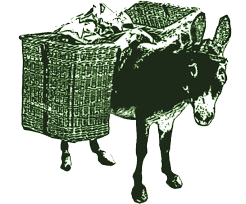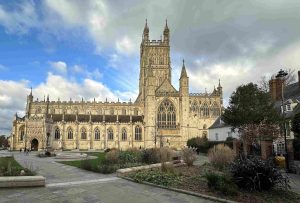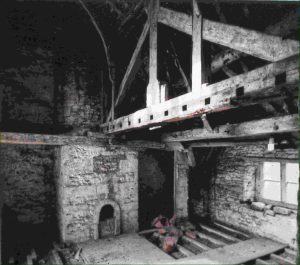Wednesday 20 November – Researching the History of Your House
A good turnout at Christ Church Chalford on a freezing cold November evening to hear Hilary and Camilla talk about how to go about researching the history of your house.
Hilary introduced the topic by saying it was rather like doing a jigsaw puzzle without a picture or any edge pieces – hard to know where to start – and it was also very easy to disappear down rabbit holes as you learned more about the people who had lived there! Camilla suggested two general interest sources that might be of use to anyone starting out – A House Through Time (based on the BBC series of the same name) and the Historic England website. It is a process that often leaves unanswered questions but can be a fascinating exercise.
Before embarking on a discussion of the possible useful sources, Hilary stressed the importance of understanding the historical and community context of the area in which the house is located. For example, in the case of Chalford Parish, the following points are of relevance:
The villages are not “traditional English villages” – in general there is no one large manor house (with the possible exception of Sturmeys Court) and the villages have grown up first as “squatters’ cottages” along the edges of Bisley Common on the spring line, and secondly as a “ribbon” development along the valley to house mill workers. The larger houses historically mostly belonged to the mill or factory owners and many former weavers’ cottages have been amalgamated together today to form larger dwellings and/or have been substantially extended. The locations and even structure of the houses reflect the steep topography of the hillsides and have also been heavily influenced by the various means of communication along the valley – turnpike roads, canal and railway.
Sources
If you are lucky enough to have the deeds to your house (might be held by a solicitor, or by your mortgage company or possibly available through the Land Registry) then these can provide a treasure trove of useful information about who lived in your house throughout its life, which then allows you to investigate what those people were doing in their lives. Hilary showed us a wonderful, framed document dating from the early 18th century, which had formed part of the deeds for Woodlands House, the property she was using as her example later in this talk.
Moving on to other sources you might use, either if you don’t have the deeds, or which you might use along with deeds to give further information, Hilary next mentioned the census. This was taken every ten years, with useful information (i.e. names of individuals) appearing from 1841 onwards up to 1921 (currently) with the 1939 Register (taken for the purpose of registering the wartime population) forming a very useful later addition. The census is available online (via paid subscription) on Ancestry (not 1921) and Find my Past (FMP). Access to both of these is free at Gloucestershire libraries (with library membership) and at Gloucestershire Archives. The census often does not give house names (except for the larger houses) but if you already know the names of the occupiers from the deeds it can be a great source of information about the ages, birthplaces and occupations of the family members living there.
Other useful sources for finding out more about the people who lived in your house include the electoral role, the birth, marriage and death (BMD) indexes, wills and trade directories such as Kelly’s.
Electoral registers up to 1974 are available on Ancestry as above (free at libraries and Glos Archives) and from 1975 at Glos Archives – though these must be ordered in advance of a visit.
BMD Indexes from 1837 (when national registration was introduced) are also available on Ancestry or FMP. Before 1837, records were of baptism, marriage and burial and were kept at Parish level in the form of Church Registers. Availability varies from Parish to Parish but many of the Gloucestershire ones have been digitised and are online at Ancestry. Note that some of the early ones can be difficult to read as the handwriting is not always the clearest – Hilary showed us an example of this!
Kelly’s Directories, which have addresses of some ordinary people as well as trade address details are online for Gloucestershire from 1897 and 1914 as part of the University of Leicester’s Special Collections. Link here
Later editions of Kelly’s from the 1930’s, 40’s and 50’s are available to view at Gloucestershire Archives. Ancestry also have some.
Gloucestershire Archives also has an index of Wills between 1541 and 1858 which can be searched for free online here
More information on Gloucestershire Wills and their availability can be found here
Moving away from records relating directly to the people who lived in the house, Hilary next concentrated on maps as a source. Useful maps include the 18th century tithe map, which gives the names of fields, orchards, and other land parcels as well as listing the owner and occupier, the 1885 Ordnance Survey Map and the wonderful, coloured maps and accompanying documents produced for the Lloyd George taxation survey in the early twentieth century.
We are extremely lucky that the Lloyd George map for our area has been digitised and can be searched in a number of ways once you have identified the property of interest. Each property or “hereditament” as they were called was given a number and once you have identified the property from the map you can then search for it in the Parish lists and find out details such as the names of the owner and occupier, the square footage, the construction of the house, the number of rooms including outbuildings and details such as whether it had “Company’s water” or a well. The general state of repair was also described, since the purpose of the survey was to assess the property for taxation.
Link to Introduction page for Lloyd George survey of Gloucestershire
Link to Gloucestershire maps (Chalford is on Box 50 of the main map and then on sheet 5 of that page).
The coloured map you will see is based on the 1882 OS map revised in 1901 and this shows the hereditaments with numbers. You can then go to the search page and look for the individual hereditament number that you want to know about. Once you have this, you click on the number to get the full details. Other searches are possible such as a complete list by parish or a search by surname.
Other sources worth considering include the following:
Newspaper reports, which may contain details about the house, the street or even the resident. There is an online newspaper archive at FMP (available free via libraries and Glos Archives as described above)
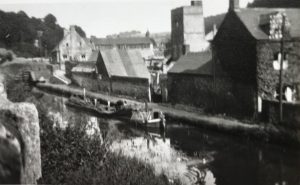
Photos from the Stanley Gardiner / Lionel Padin / Mike Mills collections. The CPLHG Committee has spent some time making detailed indexes of the slides and photos that we hold, so it’s always worth asking the question!
An inspection of the property itself may reveal how it has been changed over time. It is also worth looking at the immediate surroundings, including outbuildings, garden or any other surrounding houses.
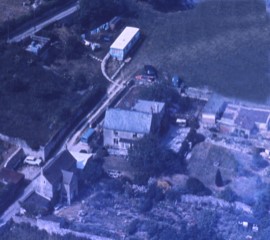
Finally, it’s worth seeing if there are any oral accounts relating to the house either from neighbours or from the CPLHG archives. In the past we have undertaken quite a lot of recording of the memories of older villagers, some of whom are no longer with us. Transcriptions of much of this is on our website. Link here
Woodlands House
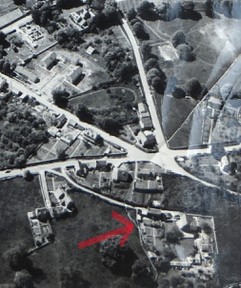
Having taken us through these comprehensive sources, Hilary then went on to discuss how she had applied them in researching the history of Woodlands House, one of the oldest properties in France Lynch, thought to date back well into the 17th Century. The history of the house name was fascinating in itself as it was not called Woodlands in the earlier records. In fact, no name was given at all for the house in the earliest documents, with the whole parcel of land being known as “Seabarns”.
Hilary traced how the name changed along with the increasing size of the house, which was originally very small. She showed us a record of the tithe payments (these are available via Glos Archives) made for the property as well as how she had traced the former owners (named in the deeds) via the census and the Lloyd George survey. She had also traced the tenants (one of whom had lived there for 50 years) via the census and (sadly) via a newspaper report which revealed that this man had in the end taken his own life while depressed. Records showed that the Gardiner family had owned the house for 86 years.
Finally, she showed us some photos which clearly demonstrate on the side elevation how the structure had grown and been extended over the life of the property.
Wharf House
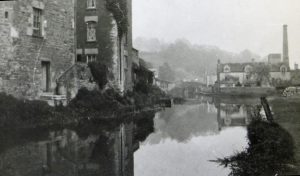
Camilla then went on to talk about the history of Wharf House, Chalford. Although it does not appear on the tithe maps, the house is known to have existed by the mid-19th century. It has an interesting structure which can still be seen today, having been built in two halves, one residential and one as stables and workshops with a cobbled floor. It was occupied by the Smart family for over 100 years, probably best known as the residence of James Smart, coal merchant who ran his coal business (using canal boats for transport) from here. Camilla was able to trace the Smart family right through the census and also showed us some newspaper articles which mentioned them and some old photos showing the Wharf in use. The Lloyd George survey shows James as the occupier and owner of Wharf House and describes the property in detail. Fred Hammond, a well-known local historian had also written about the house, as he did with many other local properties. His records have been indexed and are in Glos Archives.
Members’ Examples
In response to our request for members to share examples of their own with us, Hilary and Camilla had three further examples to present.
Chris Buckley described finding a stone mine in his garden when he moved in (not having known it was there!). He first opened this up in 2008 and believes it would have been used to build a number of the surrounding houses before being closed by the Victorians. Chris had provided some interesting photos of this.
Carole Clayton described finding a large, stone-lined hole in her garden, the purpose of which was not entirely certain, but it may have been for cold storage. Again, Carole had provided photos of this for us to see.
James Forsyth has extensively researched the property now known as Westbrook and previously as The Haven and has a significant number of documents including deeds, photos, floor plans and family photos. Time did not permit us to do justice to the amazing amount of research he has done, but Camilla showed a few examples just to give a flavour of what can be found out if you are lucky enough to have the deeds and prepared to put the work in!
Wednesday 16 October – Chalford Parish in Old Maps
Standing room only at our meeting last Wednesday on a miserable wet evening to hear our Chairman Roger Carnt talk on “Chalford Parish in Old Maps”.
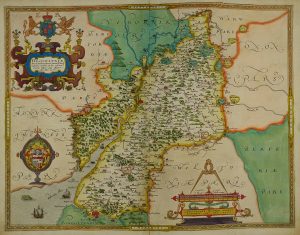
Roger began with the colourful but not necessarily very accurate Christopher Saxton map from the first collection of county maps, dated 1576. The Gloucestershire map does not actually show Chalford, neither does it have any roads!
Next we saw an Ogilby “strip map”, showing the road from Bristol to Banbury via Cirencester. As its purpose is to show the course of the road, the closest this map comes to the Parish is Coates. An example of this map can be seen here
In 1603, we get our first actual mention of Chalford on a map. Corpus Christi College, Oxford, who owned significant land as their “Chalford Estate” employed surveyors to map their land after a dispute over ownership on another of their estates. Nine fragments of that map survive in the Corpus Archives, and they give a fascinating insight into which local road, track and place names were already in use over 400 years ago. Features shown or named on the map fragments include “Queens Wood called the Frithe” (Frithwood), the line of the Old Neighbourhood Road and the track from it to the cemetery, “Stone Forde” at the bottom of Colcum (Cowcombe) Hill (possibly Stoneford / Hallidays Mill), the High Street (marked as “to Stevens Bridge”) and the line of the Black Gutter gushing into the river. A further scrap shows St Mary’s Mill and various field boundaries which are still present in more or less the same form on much later maps, showing clearly how older boundaries survive through time. We are not able to reproduce the map fragments here currently, as they are the copyright of Corpus Christi College.
The surveyor Isaac Taylor produced a colour map of Gloucestershire in 1777, with some wonderful detail. A second edition was published in 1800, although comparing the two editions (Roger showed us comparison shots of the Bathurst estate from each) it is clear that the 1777 has more detail. Chalford is named, with a cross indicating the church, and on the 1800 version, the canal is shown as a black line running through the valley with the locks all marked. Toadsmoor is marked as “Frodmore”, Lippiatt Park (sic) is shown and there is also a mystery property labelled as “Hobby House” in the Chalford Valley, west of the church. Any ideas on what this might have been would be welcome – Roger’s best guess is that it’s where Skaiteshill House now stands. The maps are held by Gloucestershire Archives, but you can view the 1800 version online HERE
In the 1780s some beautiful surveyor’s drawings of the canal were produced by John Doyley. They are hand drawn in sections, showing some wonderful details, despite being called “rough sketches”! The originals are in Gloucestershire Archives, and Roger showed us several examples of amazingly detailed drawings where the river had been rerouted in places to avoid potential problems when the canal was constructed.
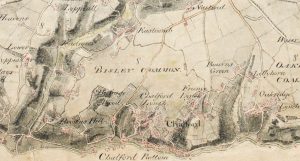
Section showing Chalford Parish. Click to enlarge
Then in 1811, Ordnance Survey made the first appearance. Robert Dawson made some preparatory “sketches” at a scale of 2 inches to the mile. The whole map of Gloucestershire, with its beautiful shading to illustrate high and low ground can be seen online HERE and an extract showing the Parish is reproduced on the right. Note that the turnpike is not yet shown and the road along the valley follows the original route along the hillside at Blackness.
Around 1824, Andrew Bryant and Christopher Greenwod each produced beautiful colour maps of the county. Greenwood’s has more detail and both can be seen online HERE and HERE
The first edition OS map was produced in 1828, and an interactive version can be seen online HERE. Bussage, Browns Hill (sic), The Frith, Chalford Lynch and France Lynch are all now named, along with a number of mills including Iles’s, St Marys, Bakers, and Ashmeads as well as Gussage and Toadsmoor in the Toadsmoor Valley. The turnpike is labelled, although the old pre-turnpike road along the valley (now a footpath) still appears. Interesting to note that “Golden Valley” is marked on the maps, so not, as often suggested, a mere Victorian invention!
Anyone who has browsed our website will be familiar with the next map Roger showed us, which was drawn by Nicholas Herbert for the Victoria County History of Gloucestershire and shows the Parish in about 1840. Link HERE
In 1841 another beautiful, coloured map was produced to show the division between Bisley and Chalford parishes. The original is also in Gloucestershire Archives.
Then in 1842, one of the most important maps of the period, the tithe map, was produced. The original map gives the details of each numbered plot. A redrawn version is available from Geoff Gwatkin which also shows the names and the use of each plot as well as having lists of the owners of each. The tithe apportionment of each plot gave details of the area (in rods, chains and perches!) and the amount owing for each plot. The tithe map can be seen online as one of the base maps on the “Know Your Place” website HERE (go to basemaps then main map and scroll down to select 1840s Gloucestershire tithes). The tithe apportionments can be searched online at Glos Archives website HERE, though they do not given the amounts charged.
In 1868 another coloured map was produced for the Parliamentary Boundaries. And in 1869 the Enclosure map was published. The latter can be seen as one of the selectable maps on the “Know Your Place” website HERE (go to basemaps, then main map and select “post-1840 Gloucestershire enclosure”).
The 1880s saw a detailed revision of the OS maps, with such minute attention being paid to the location of the boundaries that the field surveyor’s notebooks had details of individual houses and descriptions of why each should be in a specific constituency or Parish. Roger illustrated this by showing us the details of some of the houses at the extreme southwest corner of the Parish at Blackness. The originals are held by The National Archives at Kew.
AGM
Prior to the talk a short AGM was held at which the Chairman’s report and accounts for 2023/4 were presented. Members had the opportunity to ask any questions, though there were none arising. Roger Carnt thanked all members of the committee for their hard work and all agreed to stand again, which was confirmed by a unanimous vote of those present. John Dawson thanked Roger on behalf of the Committee and the membership for all his hard work on behalf of the group. There was no further business to discuss.
Wednesday 18 September – Roman Cirencester
An excellent turnout on Wednesday 18 September to hear Emma Stuart, Director of the Corinium Museum talk on the subject of “Roman Cirencester”.
Emma began by explaining where the name Cirencester actually comes from. It is thought to have been derived from “Caer-Coryn” meaning a fortified settlement at the highest point, which probably referred originally to nearby Bagendon, the existing small settlement of the Dobunni tribe but was then adapted to become the new town of Corinium Dubunnorum. The indigenous Dobunni were not conquered but rather absorbed into Roman culture, probably as a result of horse trading with the Roman army.
The first settlement at the eventual site of Corinium was a wooden cavalry fort in the 1st century AD, part of which (at Leaholme), has been excavated. A vicus or village then grew up around the settlement to provide all the usual services and trade needed by any army barracks. Finds from this period have included horse harness, saddle decoration and lots of pottery, as well as engraved tombstones, which give a lot of information about the origins of the soldiers serving in the cavalry at Corinium, who came from all over the Empire
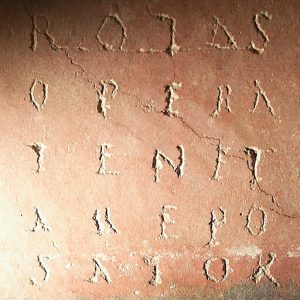
Corinium was the meeting place of three main Roman roads, Akerman Street, Watling Street and the Fosse Way, and between 80-150 AD the town was laid out with a recognisable internal street grid, including the usual Roman public buildings such as the forum and basilica. Some excavations were carried out by Victorian antiquarians such as Wilfred Cripps, resulting in finds such as an acrostic (word square) similar to one found in Pompeii.
A more recent find, probably from the late 2nd or early 3rd century is two spatha (cavalry long swords) discovered by a metal detectorist in March 2023, which are currently undergoing conservation before going on display at the museum. Fragments of a copper bowl were also found, and Historic England is planning further exploration at the site of the finds to see if there were any associated grave goods or other remains that were missed.
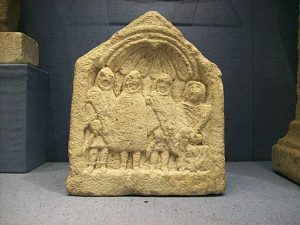
Before Christianity became the official religion of the Empire, many different Gods from the Greek and Roman pantheons, as well as some of the Gods adopted from the indigenous tribes would have been worshipped in the town. Statues of many of these have been discovered in and around Cirencester including the capital of the Jupiter Column (which would have been at the centre of the Forum), which has beautifully carved scenes of Gods including Bacchus and Dionysus.
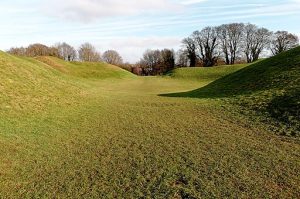
Outside the town walls was the amphitheatre, believed to have been able to hold around 8000 people. No evidence has been found that gladiatorial tournaments were held here, and it is thought to have been used for sports, theatre and military displays as well as possibly large public meetings. It was partially excavated in 1966 and as a result is thought to have originally been a limestone quarry – for the stone used to build the town – which was then adapted to another use by adding wooden seating. Thousands of nails were found during the excavation but obviously the wood had long since rotted away. Emma related the tale that when she first came to the Museum, she was told that the nails were then sold in the museum shop!
Corinium in its heyday was surrounded by stone walls with gateways, but today the only surviving visible part of these walls is in the Abbey Grounds. Most of the Roman town is now buried beneath the present-day buildings, though the outline of the basilica building is marked in the Forum Car Park by a line of brick pavers! Because the modern town is built over the Roman one, opportunities for excavation are rare. Emma described two examples – first the excavation of the Bathgate Cemetery (placed outside the town as was the custom), carried out in the 50s and 60s and revealing the graves of over 450 individuals. The second example was the accidental discovery of the hunting dogs mosaic when carrying out sewer works in Dyer Street in 1849. Emma showed us a drawing of the recovery of the mosaic, which was done by pouring plaster onto it and lifting it out in sections – not something that would be permitted these days due to the risk of damaging the mosaic in the process! The discovery of this mosaic was the inspiration for the creation of first Corinium Museum.
Emma’s talk was illustrated throughout by some excellent artist’s reconstruction drawings of the town and its buildings, as well as some interesting maps and plans, most of which can be seen on the Museum website, which is well worth a look if you are interested to know more.
Links for further reading
Corinium Museum Website https://coriniummuseum.org/
Discovery of cavalry swords (spatha) https://coriniummuseum.org/spatha/
The Jupiter Column capital https://coriniummuseum.org/2021/07/the-jupiter-column-by-isobel-wilkes/
The discovery of the hunting dogs mosaic https://coriniummuseum.org/object/1983-1-2/
Wednesday 17 July – Guided walk round Minchinhampton
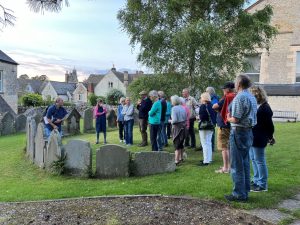
Numbers were necessarily restricted for this one and our apologies to those who did not make the final list but as the sumer walks always are, it was popular! Gary Atkinson, President of Minchinhampton Local History Group took us for a stroll around the historic sights of Minchinhampton on a beautiful summer evening with the swifts wheeling overhead. Space does not permit me to go into all the detail that Gary had prepared for us and indeed we could have continued walking for another hour if sunset had not rapidly overtaken us!
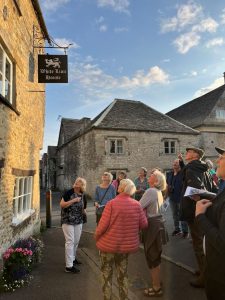
The sights seen and stories told ranged from wartime hospitals, unexploded bombs and fairs on the Common, through Minchinhampton’s many former inns (which seem to rival Chalford for an inn on every street), to the numerous shops and businesses that once thrived in the village, and included visits to both the Baptist and Parish church graveyards. Our thanks to Gary for a most informative and interesting evening.
For anyone who would like to know more, or who would like to walk around the village themselves, there is further information on the Minchinhampton Local History Group’s website HERE especially the A-Z section.
Wednesday 19 June – Four Local Stories
Our June meeting saw something a bit different from our normal format. Four Group members each gave a short presentation on a local topic of interest to them – and hopefully to the audience too.
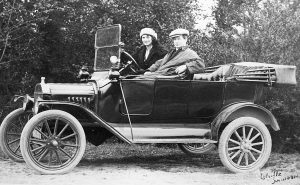
Roger Carnt started off with a story of two Chalford photographers, Charlotte Dover and Frank Colville who occupied the same photographic studio in Chalford in succession at the end of the nineteenth and beginning of the twentieth centuries. The studio (now Stephen’s Bridge Cottage) was variously known as Cadover (from Charlotte’s initials – C.A. Dover) or Spion Kop Studio (named after a Boer War defeat!).
Using census and Church Register entries and adverts from local papers and advertising publications of the time, Roger traced the personal and professional history of both photographers and their families. He than outlined the history of the studio building, with the changeover from Dover to Colville coming in 1906 when the business was sold for £70 and the studio was rented out along with it. He also showed us a number of prints from scans that have been made from some of Colville’s glass negatives that survive (now in the possession of Martin Leech).
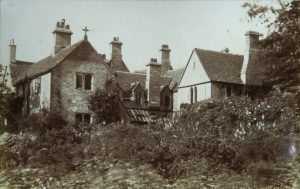
Camilla Boon then continued the evening with the story of the Bussage House of Mercy. Founded in the 1850s by John Armstrong, Robert Suckling and Grace Poole, it was initially a penitentiary for “wayward women” to escape the life of poverty and (sometimes) prostitution into which they had sunk. By 1856, both the male founders had died, and Grace Poole was left to run the institution alone for many years. After her death aged 90, it was taken over by a Community of Sisters from Wantage, though the Vicars of Bussage – notably Herbert Barchard – were also involved.
Camilla traced the development of the institution from “penitentiary” to “Laundry” to “St Michael’s Home” using census entries, reports and old photos and plans. A large laundry facility was built at the rear of the building in the early twentieth century, to allow both for training of the girls in useful skills and the provision of a service locally that resulted in an income for the Home. Camilla described her research in trying to trace the women in successive censuses after leaving the Home, which showed that some did indeed make it back into “normal” life. Changing standards for residential homes in the middle of the twentieth century eventually resulted in the demise of the Home and its sale to a religious order. Today it is a Benedictine Cistercian Monastery.
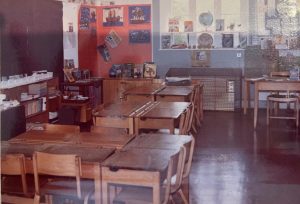
Heather Collins then described her research into Bussage School for the Chapter in Hilltop and Valley, covering both the sources she used and some of the photos that others had shared with her. With photos of examples of school logbooks, admissions registers, Victorian age grant applications and HMI reports she described the types of documents she had found at Gloucestershire Archives and the National Archives, and the stories revealed by some of them. These included some interesting snippets on the relationship between the Vicar and the Headmaster and later between the Vicar and the Gloucestershire Education Committee!
Moving on to photos, Heather discussed the varied sources for these including past and present teachers at the school, scrapbooks kept by the school, photos shared on Facebook – and how a mystery photo was dated accurately thanks to a Facebook post – and the inevitable photo that would have gone in the book but turned up too late. No matter how much you think you have researched on a subject, there is always something more to find out.
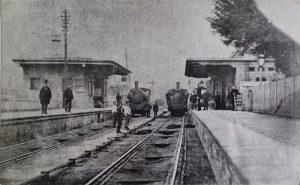
The evening was concluded by Peter Drover’s presentation “Disaster averted” the story of what almost became a terrible train disaster on the line between Sapperton and Chalford. Illustrated by pictures of the types of trains involved, the story of the excursion train to the Great Exhibition in London in 1851 gradually unfolded. Having left Chalford with 23 carriages, the train was accidentally split into two when a coupling failed, and the rearmost twelve carriages started rolling back down the incline from the Sapperton Tunnel towards the oncoming mail train which had left Brimscombe twenty minutes later.
The mail train was stopped by Thomas Gibbons, the railway policeman on duty, who felt that something was wrong though he could not say why. He then heard a rumbling from the tunnel and realising what had happened, he ran back down the track to warn the mail train. The driver of the mail train, Henry Wilkinson managed to reverse away at sufficient speed that when the collision did come it was hardly noticeable and the train was in control all the way back to Brimscombe. Several people jumped from the moving carriages fearing the worst and were injured but everyone else was unharmed. In true Victorian fashion, the excursion train returned to Brimscombe, picked up its errant carriages and continued on to London! Gibbons and Wilkinson both received rewards, though with typical Victorian inequality, Wilkinson’s was substantially more than Gibbons.’
Wednesday 15 May – Katherine Parr: Gloucestershire’s Queen
A full house at the Church Rooms on the 15 May to hear Mike Bottomley talk about Katherine Parr, the sixth and surviving wife of Henry VIII. Mike introduced his talk by reminding us what most of us had learned about Katherine at school – a middle-aged frumpy lady whose main role in life was as Henry’s nurse, bandaging his gammy leg. In the course of his research Mike has found her to be a very different person – younger, educated and altogether an amazing lady. His aim over the course of his talk was to introduce us to this person.
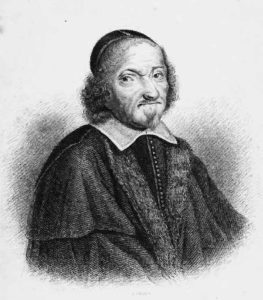
Dressed in costume as Myles Coverdale, first translator of a Protestant Bible into English and Almoner to Katherine during her time at Sudeley Castle, Mike presented the story of her life in an engaging and entertaining style, accompanied by numerous video clips of “Katherine” (filmed in the gardens at Sudeley with actors in costume) reading her letters or narrating aspects of her story to the audience.
Mike (or Myles as we should probably call him!) started by recapping the well known story of Henry VIII and his first five wives, along with some comments on Tudor fashions in hoods, with both English and French hood designs passed around for us to try on. Katherine meanwhile was born into the Parr family of Kendal (but by then living in Blackfriars, London), wealthy but not noble, and was well educated along with her sister Anne and brother William, unusual for a woman in Tudor times. Her first marriage ended in widowhood when her husband Edward Burgh died only four years after the marriage. She was quickly married again to John Neville, Lord Latimer, a step up into the senior nobility for her family. Latimer was involved in putting down a northern uprising against Henry’s dissolution of the monasteries, during which Snape Castle, with Katherine inside was taken by the rebels and Katherine was held hostage. Shortly after this she was again widowed, but as Latimer left her all his money she now found herself as a wealthy independent lady at the age of 31.
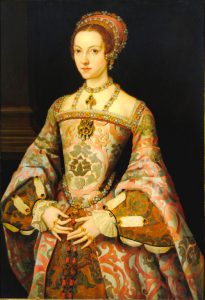
Her independence meant Katherine was able to please herself to an extent and she chose to come to Court and join her sister Anne, who had been a lady in waiting to all of Henry’s Queens, and her brother William, whose marriage had failed disastrously and was to end in divorce. On arrival at Court, Katherine met and fell in love with Thomas Seymour (brother of Queen Jane Seymour) and might have married him, except that she came to the attention of the King at about the same time. Henry VIII was not a man to say no to and eventually Katherine became wife number six. She was still only 31 at this point and not at all the middle-aged lady we tend to have in mind.
On departing for his last military campaign in France, Henry made Katherine his regent to rule in his absence, a clear indication of how much he respected her intellect and judgement. With the resources of the Court at her disposal Katherine became a scholar, leaning towards the “new” religious reform (as Protestantism was then known), employing a Latin teacher and other scholars who were considered to be at the “cutting edge” of the new thinking. She started to translate and then to write prayers and books on religious matters although these were published anonymously while Henry was still alive.
As he approached his own death, Henry began to turn back toward the Catholic faith that he had forsaken and he and Katherine started to disagree on religious matters. After an unfortunate disagreement in public, Henry was persuaded that the Queen was acting against him and signed a warrant for her arrest for heresy. This would most likely have resulted in her execution if it had been carried out, but Katherine was warned and managed to get to Henry first and persuade him that her only reason for debating with him was to divert him from the pain of his illness. They were reconciled and the guards trying to arrest Katherine were sent away by an angry Henry.
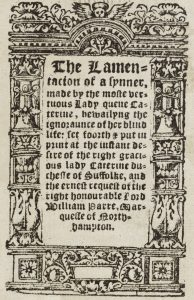
On Henry’s death, Katherine was left as the wealthiest woman in the land and was also free to marry Thomas Seymour who now returned from where he had been living overseas. They married in secret only four months after the King’s death which caused a scandal at Court. Thomas was in a constant power struggle with his brother Edward over who controlled the young King Edward VI during his minority, and there were even rows over Katherine’s jewels.
Katherine’s third book and the first to be openly published under her own name – The Lamentation of a Sinner – was published in 1547, making her the first English female author to have a book published under her own name. After three childless marriages, Katherine unexpectedly became pregnant in 1547 and moved to Sudeley Castle near Winchcombe for the “confinement” and birth. Around this time there was a scandal around an alleged relationship between Thomas Seymour (aged 41) and his ward the Lady Elizabeth (the future Queen Elizabeth I) aged just 14, which resulted in Elizabeth’s banishment by Katherine.
Katherine’s only child Mary was born in 1548, but Katherine succumbed to what was known as “childbed fever” and died less than a week after the birth. Her funeral service, the first for an English King or Queen to be held in English was at Sudeley and her body was interred in St Mary’s Chapel there. Unfortunately, the tomb was disturbed when Sudeley was destroyed at the end of the Civil War and after its “rediscovery” in the late 18th century her lead coffin was several times moved, opened and desecrated. Finally in the 1860s after Sudeley had become a private residence, Katherine’s remains were collected and interred in the beautiful marble tomb which may still be seen today by visitors to St Mary’s Church, Sudeley.
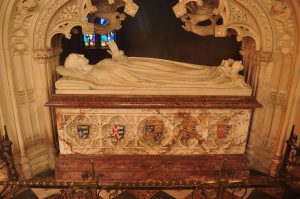
As for the other protagonists of Katherine’s story, both Thomas and Edward Seymour were executed for treason, Katherine’s daughter Mary vanishes from the history books from the age of 18 months and probably died young. Myles Coverdale, the narrator of our tale, went through several periods of exile due to his strong Protestant convictions and eventually died in his bed aged around 80.
In conclusion Mike and Myles succeeded admirably in their mission to convince us that Katherine was not at all the middle-aged nurse that we were taught about in school, but a fascinating and educated woman with her own place in English history by right.
For more information on visiting Sudeley Castle see here
Wednesday 17 April – Slides from the Michael Mills Collection and Beyond
Standing room only for our annual slide show, which this year also featured photos sent to us by others or from later collections as well as from the original Michael Mills collection. An eclectic selection presented by Camilla Boon, Roger Carnt and Heather Collins, ranging from general and aerial views of the villages, through schools, railways, snow and floods to village events from plays to the Ashmeads fair. We hope there was something for everyone and that those who recognised themselves or their relatives in a picture enjoyed the experience!
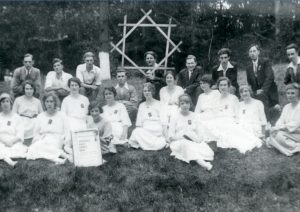
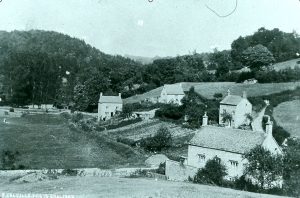
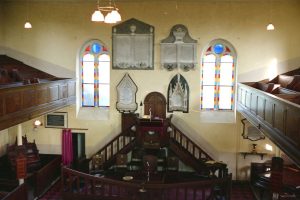
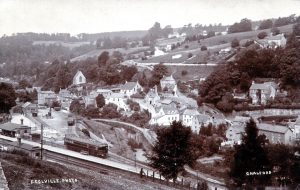
Wednesday 20 March – Gloucester Cathedral, a Royal Abbey
John Dawson, who is an official Cathedral guide gave a fascinating and informative talk on “Gloucester Cathedral, a Royal Abbey” at our March meeting. John started by noting that you can see the Cathedral everywhere you go in Gloucester and its iconic tower is visible for miles on every approach to the city.
The first Abbey was built on a neighbouring site inside the Roman Walls in the seventh century by King Osric, whose statue is in the South porch. The first Abbess, Kyneburga is also commemorated in the south aisle with a modern statue, which is carrying a bronze crook manufactured by Pangolin Editions of Chalford.
It was William the Conqueror who built a new Abbey in the location of the present building. Following the traditions of his Saxon predecessors he held three Witans or Courts at London, Winchester and Gloucester and as only Gloucester lacked a grand Abbey, he decided to have one built. The Chapter House was built first and within its walls William gave the order for the Domesday Book to be prepared. The foundation stone of what became St Peter’s Abbey and is now Gloucester Cathedral was laid in 1089 and much of the original structure is still visible today, in particular the crypt, the east end and the great pillars of the nave which still show the traces of discolouration from a fire in the twelfth century.
The location of the new cathedral caused problems almost at once as it had been inadvertently built over the filled-in ditch from the Roman walls. The building was plagued with issues in its first hundred years, the wooden vault caught fire, the walls over the old ditch started to collapse, the south tower fell down and the main tower burned down, was rebuilt with a spire and then that fell down. Eventually, early rebuilding in stone, the addition of supporting buttresses and the remodelling of the west end resulted in largely the same floor plan that we still see today. The current tower was modelled on the one at Chipping Camden and contains the bell Great Peter which at just under three tonnes is the largest medieval bell in Britain.
Gloucester has a number of Royal connections. Robert, Duke of Normandy, eldest son of the Conqueror who was dispossessed and imprisoned by his brother Henry I is buried here. Henry III the son of King John was hurriedly crowned here as it was the nearest suitable building after the death of his father. Edward II, who was imprisoned and foully murdered in Berkeley Castle is buried here in an ornate tomb raised by his son Edward III who also had extensive rebuilding in the new Gothic Perpendicular style carried out in his father’s memory.
The magnificent Lady Chapel was added in 1450 and the cloisters – made famous worldwide as part of Hogwarts for the Harry Potter films – were also finished in the 1400s. Henry VIII came to Gloucester on a royal progress in 1535 and visited the Abbey, which was consequently spared from the worst excesses of Thomas Cromwell’s reformers a few years later.
Since the Reformation Gloucester Cathedral has continued to play a rich part in the history of the area and the country. During the Civil War, Parliamentarian troops used the tower as a lookout point during the siege of Gloucester. Edward Jenner who was born in Berkeley and is regarded as the inventor of modern vaccination is commemorated with a statue in the nave. The Victorians carried out extensive renovations, especially within the Quire. In WW2 the Coronation chair was brought here from London and safely stored in the crypt. In 2015 Gloucester became the first Church of England Diocese to have a female Bishop.
Space does not allow us to recount all the amazing detail that John presented on the evening, so we highly recommend that if you are in Gloucester, you visit for yourself and maybe take a guided tour.
Links for further information
More on the heritage and architecture of the Cathedral
Wednesday 21 February – Industrial Heritage of the Forest of Dean
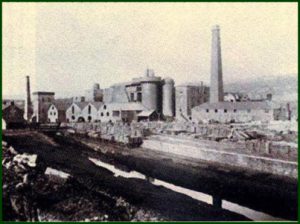
Dr Ray Wilson, a retired nuclear physicist who was the Secretary of the Gloucestershire Society of Industrial Archaeology for over 40 years gave a fascinating and informative talk at our February meeting on the industrial heritage of the Forest of Dean.
Ray began by briefly introducing us to the geography, geology and history of the Forest of Dean, a Royal hunting forest since Saxon times, which is now partly in public ownership and partly owned by the Crown. He also discussed some of the ancient traditions and offices such as the Verderers’ Court at Speech House and the right of those born in the “Hundred of St Briavels” to act as Free Miners which still exist today.
Iron, coal and stone are thought to have been mined or quarried in the Forest since Roman times. In their heyday these industries employed thousands and some of the sites, such as Cinderford Ironworks (developed by the South Wales Crawshay iron masters) and Foxes Bridge Colliery just outside Cinderford were surprisingly extensive.
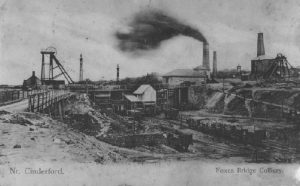
Through a series of his photos, Ray showed us how glimpses of the Forest’s industrial heritage can be seen all around the area if you know what to look for. Examples include vertical mine shafts or horizonal adits dug by miners into the hillside, ventilation chimneys for underground mines, furnace buildings, former stone quarries, remains of tramway or railway lines used for transporting the heavy product, tunnels, bridges, and viaducts.
Signs are also visible in non-industrial buildings which have often survived the demolition of the Works they once supported, such as Managers’ houses or industrial housing for workers (unusual in Gloucestershire), and also in Newland Church, dubbed “The Cathedral of the Forest”, which houses the famous Freeminer brass.
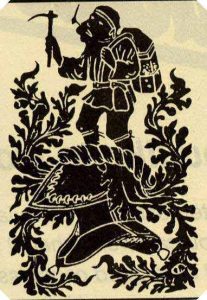
By Dooshy68 – Own work, CC BY-SA 3.0, Creative Copyright Link
Among the more important sites mentioned by Ray during the talk and well worth a visit are the following:
Dark Hill Iron Works. Developed by the Mushet family, father and son David and Robert, where they carried out secret experiments to improve the steel-making process. Robert discovered the secret to improving the existing Bessemer steel process, which was subsequently exploited commercially by Henry Bessemer, who eventually agreed to pay him a pension of £300 per year rather than see him living in poverty. Today only low walls and the outlines of tramways and roadways from the works are left on this site and the neighbouring Titanic steelworks.
Bixhead stone quarry and Bickslade tramway. There is still one working quarry here, but there are also extensive abandoned quarry workings and some lovely walks up the old tramways. These were originally horse-drawn tramways, but most were eventually developed into narrow gauge railways. Ray also described how the railways developed across the Forest as a transport network to take the coal to the ironworks and further afield to the River Severn for onward transport by boat.
Lydney Harbour. Coal from the Forest was brought here by railway and loaded onto small boats. Although partly fenced off at the moment for safety reasons the harbour and walk along the adjacent foreshore still shows signs of the former activity, with some remains of old boats visible at low tide. The building of the Severn railway bridge allowing the coal to be taken in wagons direct to Sharpness effectively signalled the end of Lydney as a coal port. Ray also described the Severn Bridge disaster of 1960 when two barges collided with one another and then with the bridge, bringing down two full spans and killing some of the boats’ crews. Today little is left of the bridge, though the tower of the swing section over the canal still remains.
Whitecliff iron furnace. This relatively well-preserved building used for smelting iron using coke as a fuel was in fact not a very successful site, which is why it probably survives today instead of having been rebuilt successively as some of the other sites have been.
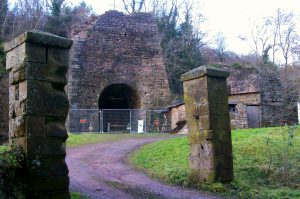
by Obscurasky – Own work, CC BY-SA 3.0, Creative Copyright link
Gunn’s Mill Furnace. Originally a 17th century blast furnace powered by charcoal and then a paper mill it has fallen into a very poor condition. The Forest of Dean Buildings Preservation Trust have recently been granted money by Historic England to allow for restoration and preservation.
Ray also briefly mentioned other local industries such as brick making and printing, which had grown up to support the main Forest industries and concluded with a mention of the Dean Heritage Centre in a former mill which today is a museum with extensive displays.
Links for those interested in further reading on the Forest of Dean and on industrial archaeology in Gloucestershire.
Gloucestershire Society for Industrial Archaeology https://gsia.org.uk/
Dean Heritage Centre https://www.deanheritagecentre.com/
David and Robert Mushet https://www.visitdeanwye.co.uk/explore/famous-people/david-and-robert-mushet
The “Cathedral of the Forest” https://www.allsaintsnewland.com/
Gunns Mill preservation project https://www.fodbpt.org/gunns-mill
Whitecliff ironworks https://www.visitdeanwye.co.uk/things-to-do/whitecliff-ironworks-p1356061
Free miners in the Forest https://www.forestfreeminers.org/
Wednesday 17 January 2024
John Peters gave a fascinating and varied talk describing his experiences as a volunteer photographer for English Heritage (now Historic England), helping to compile the photographs of buildings used on their Listed Building website. Having started the project in 1999, Historic England had to appeal to volunteers to help them complete it. John was provided with a list of “targets”, many of which were not whole buildings at all but included structures such as gate posts, bridges and churchyard monuments.
John described for us many of his favourite assignments including Daglingworth Church, which dates from Saxon times, and the “step pyramid graves” in St Laurence Churchyard Stroud and urged us to go and see both of these if we had not already done so.
He also entertained us with stories of some of his more difficult assignments including houses where the owners refused him access, the building that was almost imposisble to photograph as it was in such a narrow street and the various “technically illegal” photos he was asked to take of jails and schools.
